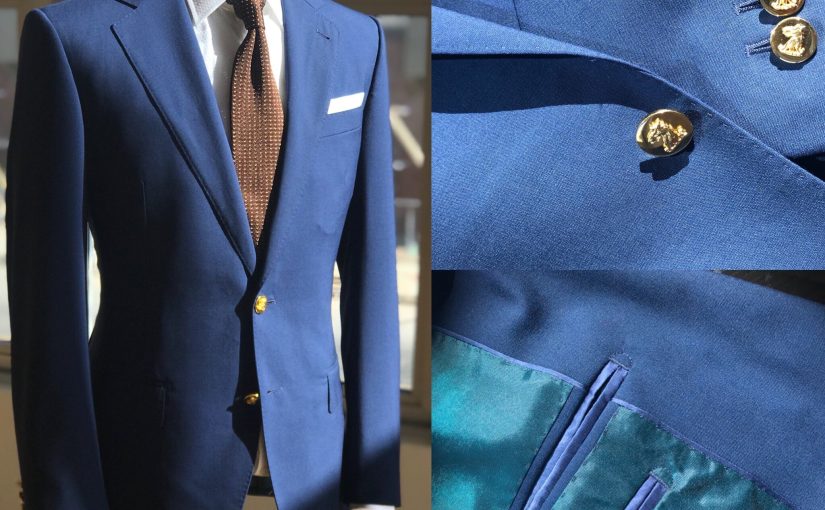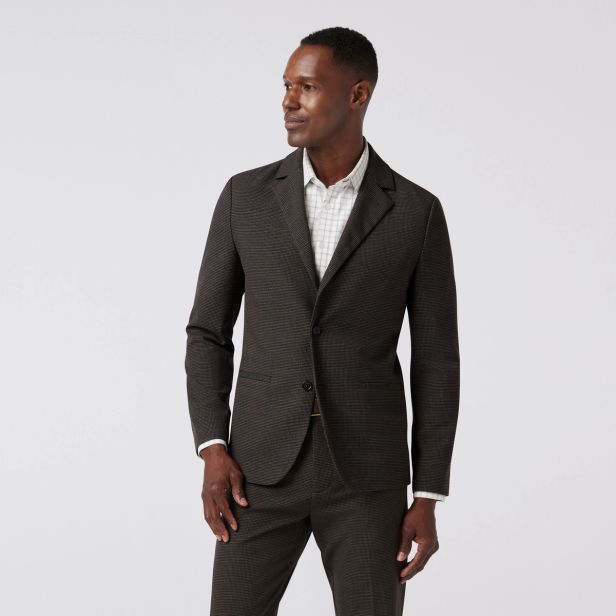Introduction to Men’s Tailored Jackets
In the world of men’s fashion, tailored jackets are key. They shape your style and set a tone for your outfit. It’s essential to understand the types of jackets out there. We’ll focus on two popular choices: the blazer and the suit jacket.
A suit jacket is a tailored piece, usually made to match suit trousers. It’s a staple for formal events. Think weddings, high-stakes meetings, or even courtroom appearances. Suit jackets exude professionalism.
Blazers, by contrast, are your versatile pals. They’re less formal than suit jackets but more so than casual wear. It’s the jacket that accompanies you to dinner dates, office Fridays, and semi-formal gatherings.
Men’s tailored jackets come in many styles and materials. Factors like fit, fabric, and detailing all play a part in the difference between blazer and suit jacket. Blazers allow for mix-and-match with different trousers, while suit jackets call for their matching pair. This distinction is crucial when planning your wardrobe.
The use of tailored jackets spans a wide range of social scenarios. They can boost confidence, showcase personal style, and command respect in various settings. As we dive deeper, keep these basics in mind. Whether you reach for a suit jacket or a blazer can make or break your look.
The Suit Jacket: Definition and Characteristics
A suit jacket is a key part of men’s formal attire. It pairs with matching trousers to create a cohesive look for formal events. Quality materials like wool, cashmere, or silk are common in suit jackets. These jackets are tailored to fit closely and shape the body neatly. They feature a structured shoulder and a fitted waist for a polished look. The length of a suit jacket often extends just enough to cover the hips.
Typically, a suit jacket has two or three buttons on the front. Depending on the style, they can be single-breasted or double-breasted. The lapels on the jacket can be notched, peaked, or shawl. The choice of lapel usually depends on the specific style and formality of the event. For a complete and professional appearance, suit jackets are worn with accessories like watches, cufflinks, and pocket squares.
Ultimately, suit jackets serve as a staple in the professional world, enhancing one’s appearance at work, in interviews, or at formal occasions such as weddings. They underline sophistication and are crucial for a sharp, well-dressed look.
The Blazer: Versatility and Style
Blazers break the mold of strict formality and offer flexibility in men’s fashion. Unlike suit jackets, blazers embolden one’s wardrobe with extensive pairing choices. Whether it’s jeans for a casual look or slacks for business casual, blazers adapt seamlessly to both. They typically feature a relaxed design that is less rigid than their suit jacket counterpart.
The array of materials—wool, cotton, or linen—presents endless variety. Colors too span a broad spectrum. Blazers step out in bold hues, subtle tones, and diverse patterns. Distinctive buttons and pocket details further characterize this jacket’s unique flair.
Owing to such adaptability, the blazer is a go-to for semi-formal occasions, dinner parties, or refined casual settings. It’s the perfect balance between sharp presentation and ease of wear. With a well-chosen blazer, personal style shines through without compromising on elegance.
In essence, the blazer is the multipurpose piece that elevates everyday dress. It’s a key asset that moves beyond the constraints of matching pairs and showcases versatility with style.
Key Differences Between a Suit Jacket and a Blazer
Identifying the key differences between a suit jacket and a blazer is crucial for dressing appropriately for various occasions. While both garments enhance a man’s wardrobe, they serve differing purposes and are constructed differently.
- Matching Pants: Suit jackets almost always require matching pants, made from the same fabric. Blazers, however, offer the flexibility to pair with different types of trousers—from jeans to dress pants.
- Structure: The design of a suit jacket is inherently more formal. It features a close fit, structured shoulders, and precisely tailored lines. Blazers are generally less structured with a more relaxed fit, which increases their versatility in casual and semi-formal settings.
- Material Usage: Suit jackets typically utilize luxury materials like wool, silk, or cashmere, emphasizing their formal appearance. Blazers are made from a broader array of materials, including wool, cotton, or linen, allowing for casual or semi-formal wear.
- Versatility: A blazer shines in its versatility. It can be dressed up or down to suit various events, making it a more adaptable garment. Suit jackets are best reserved for formal occasions where a professional or elegant appearance is required.
- Formality: As the cornerstone of formal attire, suit jackets are a must for events like weddings or corporate meetings. Blazers can navigate between informal and semi-formal events with ease, providing a sharp but versatile option.
Understanding these differences ensures that you select the appropriate jacket for any occasion, making you look sharp and appropriate wherever you go.
Occasions for Wearing Suit Jackets versus Blazers
Choosing the right jacket for the right occasion is pivotal in men’s fashion. Both suit jackets and blazers elevate a man’s ensemble, yet they are each suited to different scenarios.
Suit Jackets: Well-fitted suit jackets are the gold standard for formal events. These include weddings, high-profile business meetings, or any setting that calls for traditional business attire. For instance, when a sharp, authoritative look is required, reach for the suit jacket.
Blazers: Meanwhile, blazers are the kings of versatility. They can take you from a business casual office environment straight to a relaxed dinner date. Blazers work well for events such as garden parties, art gallery openings, or smart-casual networking events, where the dress code is less stringent yet a touch of elegance is still appreciated.
For semi-formal to informal settings, a blazer is an excellent choice. With a blazer, you can create a smart ensemble that’s not overdone, perfect for situations where you want to look well-dressed but not overly formal.
In summary, suit jackets are tailored for formality, matching pants, and precision, while blazers offer a relaxed fit, adaptability, and a pinch of flair. Respecting the difference between blazer and suit jacket ensures that your attire is always event-appropriate and stylish.
How to Pair Blazers with Different Outfits
Blazers are the Swiss Army knife of men’s wardrobes: versatile, adaptable, and always in style. The key to pairing a blazer with different outfits lies in understanding color coordination, contrasting textures, and the formality level of the occasion.
- For a Business Casual Look: Combine a navy blazer with a pair of khaki chinos, a white button-down shirt, and brown leather shoes. This classic combo works well for office settings or casual business meetings.
- Casual Outing Ready: Pair a lighter colored blazer, like gray or beige, with dark denim jeans for a smart yet relaxed look. Add a casual T-shirt or a lightweight sweater underneath, and complete the ensemble with sneakers or casual loafers.
- Event Versatility: When attending semi-formal events, opt for a blazer in a dark color like black or charcoal. Coordinate with dress slacks, a crisp shirt, and dress shoes. Accessorize with a silk pocket square for a touch of sophistication.
- Layering Masterpiece: For cooler weather, layer a blazer over a cozy turtleneck. Choose textured fabrics like tweed or herringbone to add depth to your outfit, and finish off with sturdy boots.
- Summer Chic: In warm weather, a light linen blazer paired with cotton pants or even tailored shorts can provide a chic and comfortable outfit. Finish with boat shoes or loafers for a polished summer vibe.
Remember, the key is to match your blazer with outfits that keep balance—neither too formal nor too casual. A well-chosen blazer can enhance nearly any outfit, making it an essential piece for any style-conscious individual.
The Formality Spectrum: Suit Jackets at Professional Events
When mapping out the formality spectrum, suit jackets sit at the high end. Here’s why:
- Professional Polish: Suit jackets bring a level of polish that’s expected at professional events. Their matching trousers and tailored fit mean business.
- Material Matters: They’re made from premium materials like wool and silk. These add to their formal allure.
- Design Details: The structured shoulders and fitted lines of suit jackets indicate formality. These details set them apart at events.
- Accessory Integration: Pairing a suit jacket with a tie, cufflinks, and a pocket square completes the professional aesthetic.
- Event Expectations: At events like conferences, galas, or court appearances, suit jackets are almost a given.
- Color Consistency: Typically, they come in traditional colors such as black, navy, or gray. These colors are synonymous with formal attire.
Suit jackets are non-negotiable for certain professional settings. They communicate respect and credibility. For any formal event where you aim to impress, a suit jacket is the go-to. Remember to focus on the fit and finish to ensure your appearance is impeccable.
Essential Tips for Choosing Between a Blazer and Suit Jacket
Navigating the nuances of men’s fashion can be a challenge. Deciding whether a blazer or suit jacket is most suitable for a particular event doesn’t have to be complicated. Here are some essential tips to ensure you make the right choice every time.
- Understand the Occasion: Before choosing, think about where you’re going. Suit jackets are best for formal events; blazers for less formal ones.
- Invest in Quality: Choose high-quality fabrics for longevity and a polished look. Wool for suit jackets, varied materials for blazers.
- Fit is Key: Ensure your jacket fits well. A tailored fit makes a difference, whether it’s a suit jacket or a blazer.
- Versatility Matters: Blazers offer versatility. If your wardrobe is limited, they’re a smart choice. They pair well with different trousers and situations.
- Accessorize Wisely: Accessories can transform your look. Use them to dress up a blazer or add finesse to a suit jacket.
- Mind the Details: Pay attention to the lapels, buttons, and pockets. These details can influence the formality of the jacket.
- Color Coordination: Consider the color of the jacket and how it matches with the rest of your outfit. Neutral colors are safe; bold colors make a statement.
- Seasonal Considerations: Choose heavier fabrics in winter, like tweed, and lighter ones, like linen, in summer.
- Budget Accordingly: Blazers can be less expensive and offer more outfit options. Suit jackets might cost more but are essential for certain occasions.
Remember these tips when you’re standing before your wardrobe. Whether you’re dressing for a job interview, a wedding, or a casual meet-up, your choice in outerwear should be deliberate and confident. By following these guidelines, the difference between blazer and suit jacket will become second nature as you build a stylish, adaptable wardrobe.


